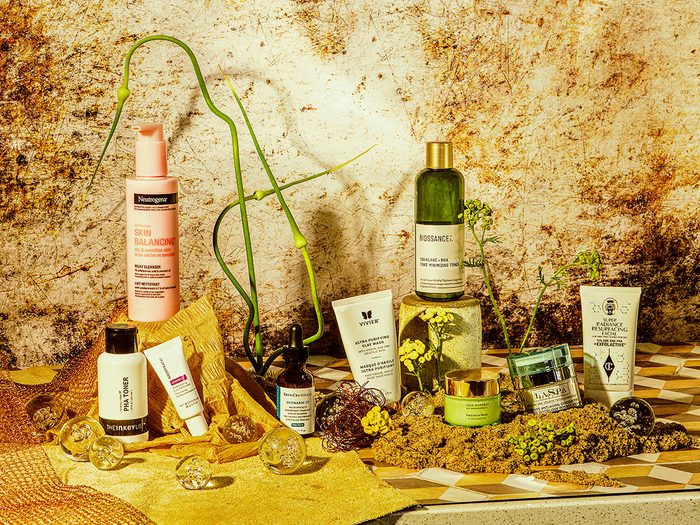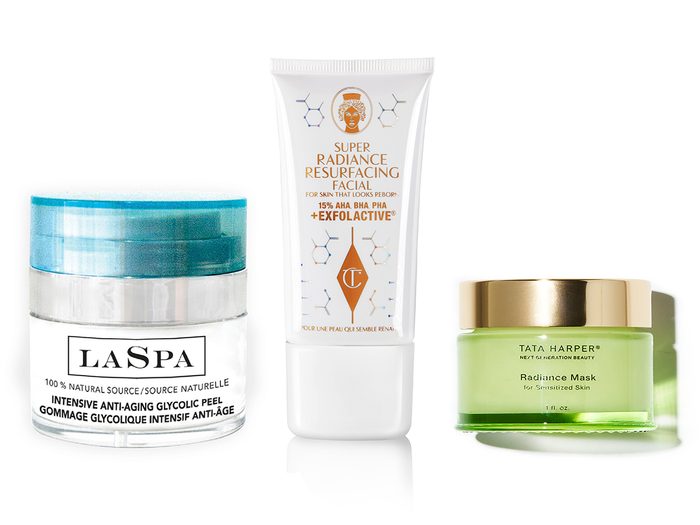Skin Feeling Oily, Parched or Stressed? Consider Acids for Skin Care
1 / 5


An in-the-know guide to four powerful active ingredients
When it comes to skin care, knowledge is power, and we’re getting smarter. “Since the pandemic, people are actively seeking information through online tutorials and masterclasses,” says Patricia Clare, a Vancouver-based national trainer for NeoStrata, an anti-aging skin care line. “They’re really trying to put it together. I’ve never seen anything quite like it.” Understanding that desired results are anchored to key ingredients is part of the journey to building a skincare routine that works, and so is an introduction to acid ingredients.
“Traditionally, acids are mostly keratolytics, which are ingredients that help the skin turn over and shed [dead cells] properly,” says Dr. Geeta Yadav, a dermatologist at Skin Science Dermatology in Toronto, “They add brightening and renewal – the glow effect.” But wait, there’s more! Beyond that core group of chemical exfoliants, you’ll find other notable acids that can elevate a routine by increasing hydration or reducing blemishes.
And despite the harsh name, you don’t need a drastic reason to consider incorporating an acid ingredient into your skin care routine. According to Clare, observing that something is suddenly different (such as the onset of clogged pores, skin that’s rougher or discolouration) is a legit motive to prompt an investigation. Read on to learn more about popular acid ingredients, and know this: “It’s not about which one is the best acid,” says Clare, “but which is the best one for you.”
Note: Generally, acids can be used in a routine that also includes retinol, another powerful active ingredient, however due to retinol’s innate sloughing action, layering it with acids is not advised and can increase potential skin irritation.
2 / 5


AHAs
Alpha Hydroxy Acids (AHAs) are a group of ingredients that dissolve the bonds between dead skin cells. “AHAs have that turnover effect,” says Yadav, “They also increase collagen production and decrease melanin production.” Prevalent types include glycolic, lactic, mandelic, tartaric and citric acid, with the former the most well-known of the bunch. “The reason glycolic acid is the kingpin of AHAs is that it has the smallest molecular weight, so it’s quickest [to get] into the skin,” says Clare, who likes the ingredient for a range of objectives. Using glycolic acid to get rid of dead skin cells can help unify a combination complexion, helping dry areas hold on to moisture better and reduce breakouts for oilier parts, she says.
Best for: normal and/or combination skin.
Try:
1. Made with natural and organic ingredients, this treatment utilizes glycolic and hyaluronic acids to exfoliate while hydrating.
LASPA Intensive Glycol Peel (10%) Overnight Treatment, $130, thedetoxmarket.ca
2. With a hefty mix of acids and a luxe gel texture, this weekly treatment reveals radiance in 20 minutes.
Charlotte Tilbury Super Radiance Resurfacing Facial, $85, charlottetilbury.com
3. This mild and nourishing blend features phytic and lactic acids to gently promote cell turnover.
Tata Harper Superkind Radiance Mask for Sensitized Skin, $87, tataharperskincare.com
